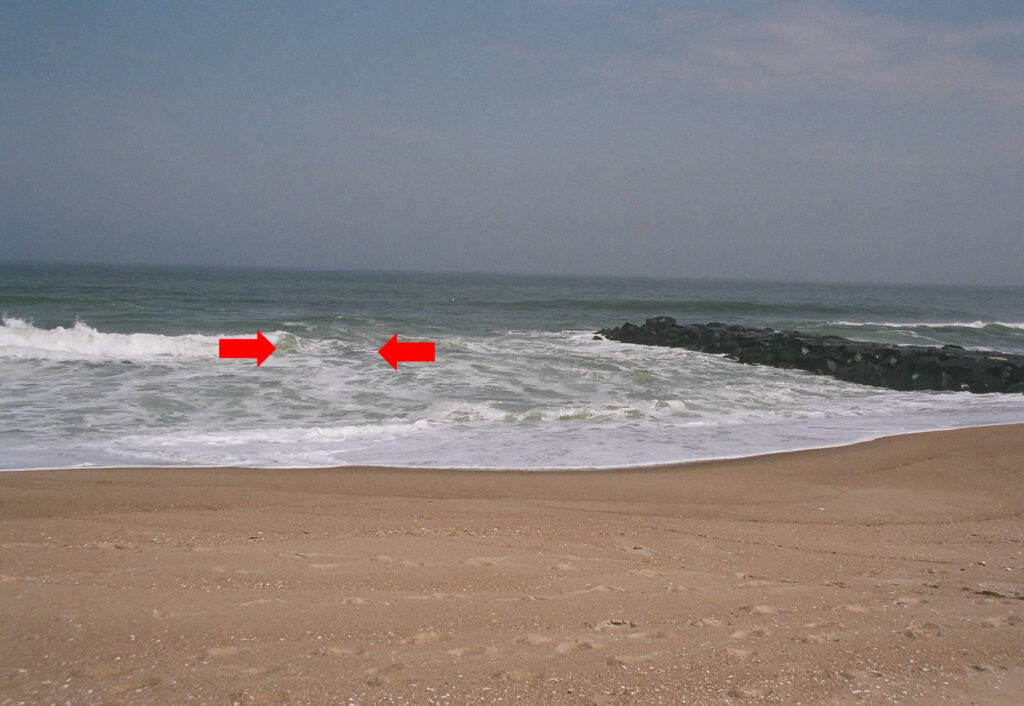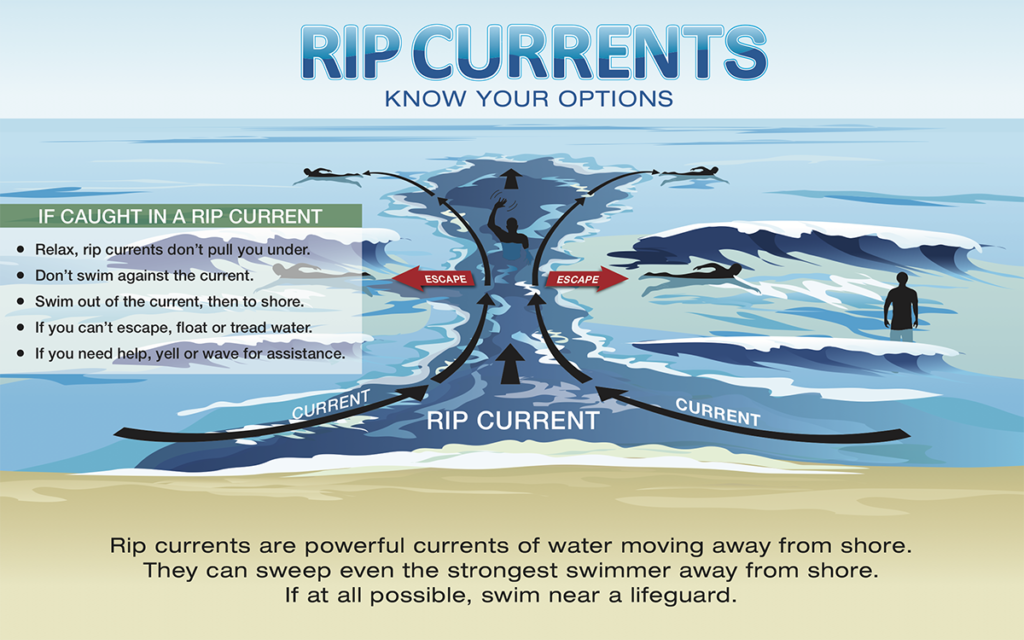
Rip Current Safety
Research, tips, and resources to help beachgoers stay safe from rip currents.
On This Page
What are Rip Currents?
Rip currents are strong, channelized currents that move water away from the shoreline and towards the ocean.
The flow of a rip current is like a treadmill that can pull people away from shore. This motion draws people further out but does not pull people underwater. Rip currents can be narrow or up to hundreds of yards wide. The length of a rip current also varies. Sometimes rip currents end just past the point of breaking waves, but they can also continue for hundreds of yards. Rip currents slow down the farther away from the beach.
Rip currents are the leading surf hazard for all beachgoers. The U.S. Lifesaving Association reports 80 percent of all surf rescues are related to rip currents. On many beaches, rip currents are present every day and speeds are too slow to be a danger to most swimmers. However, when wave conditions, shape of the offshore beach and tide elevation are just right, rip currents can reach dangerous speeds.
How Do Rip Currents Form?
Rip currents form when waves moving towards the shore push water up the beach’s slope.
When waves break along the shore, water piles up. Rip currents can form when water that is being pushed onto the beach tries to return back to the ocean. This causes a strong and swift current to form that draws the water back out.
Where are Rip Currents Found?
Rip currents are found anywhere breaking waves are present, including ocean, sea, and lake coastlines. Rip currents can form on almost any beach at any time of year. They can often be found around edges of sandbars and near structures like jetties or piers.
These obstacles prevent waves from returning to sea in a direct path. When the water from the waves finds a path around the obstacle, the stream of water can become a rip current.

How to Spot a Rip Current
The signs of a rip current can be challenging to identify, even for the most experienced observers. Even in calm, steady conditions, a rip current can form rapidly without any warning signs.
It is easier to spot a rip current from a higher vantage point, like a beach access overlooking the shore. Pause and scan the water for these key signs:
- Look for a narrow strip of water that’s a different color than the surrounding area, it will be either lighter or darker.
- Sometimes a rip current can look like a patch of unusually foamless water or a patch of churning, choppy water.
- The water may look like it is moving quickly towards the ocean. Look for the direction that foam, suspended sand, or debris is floating, if it is being pulled towards the ocean, it may be a rip current.
It’s essential to remember that rip currents may not always present the same visual signs and can be difficult to spot.

Plan Ahead: Check Rip Current Conditions
Visual identification should not be the only source you rely on when checking for rip currents. Review the National Weather Service’s Surf Zone Forecast. Use the map to select the region the beach you are going to visit is within. Once the forecast report is created, find the beach you are visiting and look for the “rip current risk”.
Find rip current and beach safety forecasts or alerts at the following resources:
At the beach, ask lifeguards or beach patrol about the current water conditions. Know where emergency flotation devices are located, swim near lifeguard stations, and never swim alone.
Why are Rip Currents Dangerous?
Rip currents pull people away from shore and into deeper waters. People often attempt to swim against the current and become exhausted before they can return to shore.
Rip current speeds are fast. They average 1 to 2 feet per second but have been measured to reach up to 8 feet per second —faster than an Olympic swimmer.
Slow rip currents are present on most beaches every day, but when the wave, tide, and shape of the beach conditions are just right, rip currents can accelerate to become dangerous very quickly.
The U.S. Lifesaving Association reports 80 percent of beach rescues are related to rip currents.
Listen to this WTKF interview about Rip Currents by NC Sea Grant extension specialist Spencer Rogers. Rogers discussed how to visually identify some of the subtle indicators that a rip current might be present on the beach.
How to Escape a Rip Current

- If you become caught in a rip current, try to remain calm to conserve energy by floating.
- Do not swim against the current. Instead, swim parallel to the shore to get out of the rip current.
- Once you no longer feel the pull of the current, swim back towards shore.
- If you can’t escape the current, float or calmly tread water.
- If at any time you feel you will be unable to reach shore, draw attention to yourself: face the shore, wave your arms, and yell for help.
How to Help Someone Else Caught in a Rip Current
- If you see someone caught in a rip current, immediately alert a lifeguard.
- Throw any floating device such as a bougie board or even a cooler to help the victim float.
- If a lifeguard is not available, call 911.
- Try to direct the victim to swim parallel to the beach to get out of the current.
- Don’t attempt to perform the rescue yourself. Even trained lifeguards only make this attempt with a flotation device. Do not enter the water without a flotation device.
- In NC, about 30% of rip current drownings have been rescuers. In many cases, the original victim will survive, but the rescuer becomes exhausted while performing the rescue.
Rip Currents in North Carolina
Rip currents account for the highest number of weather-related fatalities in the coastal Carolinas. Between 2000 and 2024, there were 192 rip current drownings (~8 per year) reported in North and South Carolina.
Rip currents can be affected by extreme storms. Even tropical storms that are thousands of miles away can cause rip currents. In 2019, Hurricane Lorenzo generated an outbreak of deadly rip currents along North Carolina despite being over 1,700 nautical miles away. This led to 4 rip current deaths in North Carolina. The number of rip currents in Wrightsville Beach, NC has correlated with the peak of the Atlantic hurricane season during the month of September.
10% of rip current fatalities in the Carolinas between 2000 and 2022 have been due to swells from tropical cyclones. Warm and clear local conditions during distant storms can create a false sense of security. The distance of far away storms can create a false sense of security because of the warm and clear local weather conditions.
NC Sea Grant Rip Current Research
Exploring Rip Currents — Learn about North Carolina Sea Grant’s rip current research using data-logging drifters to track the circulation in and around rip currents. Researchers designed the drifters to float and mimic the behavior of a swimmer. This data has been critical for National Weather Service and the U.S. Lifesaving Association in enhancing warning and escape procedure messages.
Coastwatch Magazine
Model Behavior — the award-winning feature in Coastwatch magazine on the latest in rip currents forecasting and modeling by considering wave conditions, tides, and the shape of the sea floor to predict the probability of rip currents. This model allows us to predict rip currents up to six days in advance.
To Catch a Current — What is a data-logging drifter? Data logging drifters are sensors that mimic the flotation of a swimmer in the water and record position over time. This research has provided critical insight on how to survive a rip current by staying calm and floating.
NC Partners Focus on RipCurrent Safety — NCSG partners with NOAA, USLA, NWS, National Park Service, and local safety officials to promote rip current safety awareness. Rip currents pose a threat to local residents and visitors alike, sharing life saving information is a responsibility for all.
Rip Currents in the News
- WRAL spoke with NC Sea Grant’s Spencer Rogers about the threat rip currents pose
- WWAY spoke to NC Sea Grant about how specially made drifters gather data from rip currents
- WECT talks to NWS and Ocean Rescue professionals during Rip Current Awareness Week
- The News and Observer spoke to NC scientists on the danger of rip currents
- Good Morning America featured NC Sea Grant’s Spencer Rogers on ways to survive a rip current
National and State Partners
National Weather Service offices in North Carolina are key partners in working with state agencies and beach communities’ ocean rescue teams. NWS Wilmington, NC has an outreach partnership with NC Department Health and Human Services to reach audiences of people who are deaf and hard-of hearing.
Partners for North Carolina Sea Grant research include:
- UNCW Center for Marine Science
- NWS Wilmington Forecast Office
- U.S. Army Corps of Engineers
- Ocean rescue programs in Carolina Beach
- Wrightsville Beach, Kill Devil Hills and Kitty Hawk
- UNCW Surf Club
- Wrightsville Beach Longboard Association
- Tony Silvagni Surf School in Carolina Beach
- CB Surf Shop in Carolina Beach
- University of New South Wales
